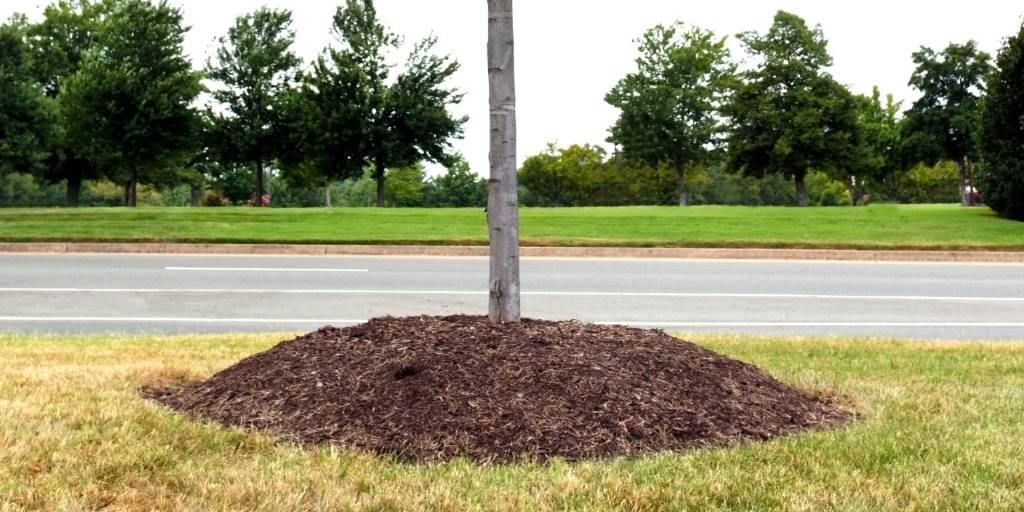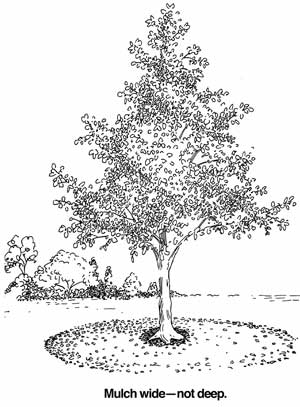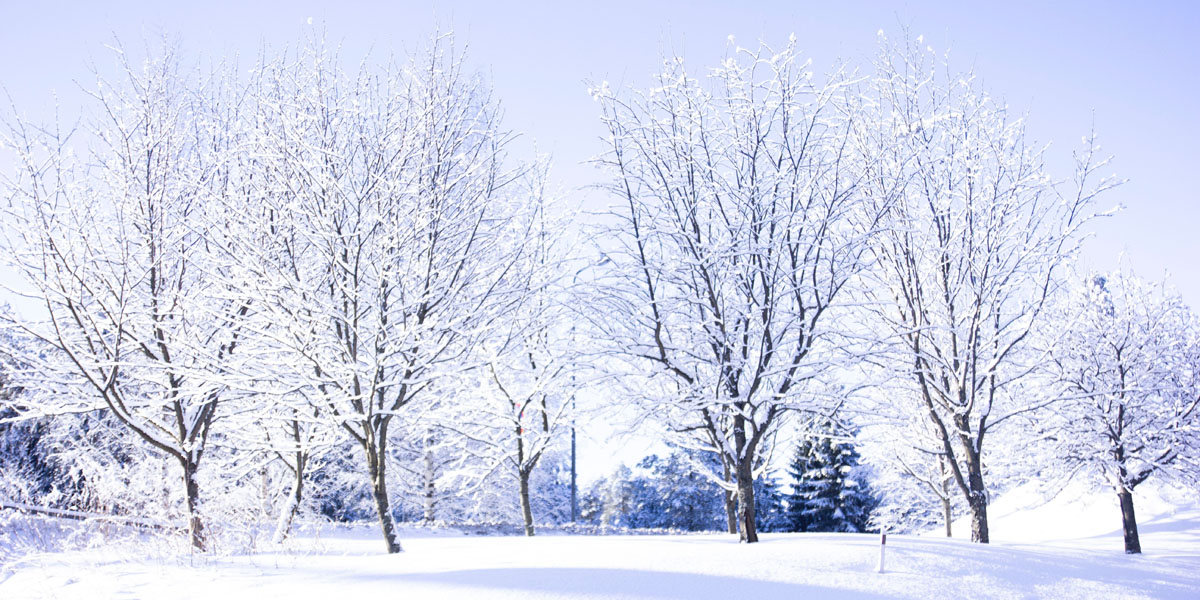Each spring, you probably hear the advice to spread mulch around trees, shrubs, and garden beds. But what’s the right amount mulch to use? Should you pile it around the tree to create a “mulch volcano”? Does it matter where you place the mulch? And is it really worthwhile?
We answer those questions and more in this article about the proper way to mulch trees and the effects of volcano mulching.
FAQs About Mulch Volcanoes & Mulching Trees
What is mulch?
Mulch is a layer of material that is spread on the soil’s surface. It comes in two types: organic mulch and inorganic mulch.
Organic mulch comes from items that were once living, such as grass clippings, coco hulls, straw, wood chips, shredded bark, and even compost.
Many people use wood products as mulch in the landscape. You can buy shredded bark or wood chip mulch in bags from most garden centers or big box stores. It can also be purchased in bulk from a landscape supply company or a tree service.
If you need wood chips for mulch, call Alpine tree. We give it away for free!
In contrast, inorganic mulch is made from non-living materials such as plastic, shredded rubber, gravel, and landscape fabric.
Which type of mulch is best for my trees?
We always recommend using organic mulch around plants, including trees.
Research shows that the best type of mulch for trees and shrubs is fresh arborist wood chips. However, they would not be a good choice for mulching around shallow-rooted annuals, vegetable beds, or newly-planted perennials.
Why are arborist wood chips the best mulch for trees?
Unlike inorganic mulches, organic mulches break down over time and contribute to improving the health of the underlying soil.
Arborist wood chip mulch includes bark, wood, and leaves (unlike bark mulch or that made from hardwoods or recycled pallets, for example). As a result, it:
- is less likely to compact (compacted mulch can repel water),
- provides a more diverse environment that supports a variety of microbes, insects, and other organisms, and
- makes trees and shrubs more resistant to environmental stresses and creates a healthier plant environment.
Arborist wood chips are particularly effective at building soil health and are also longer lasting than materials that decompose more quickly, such as grass clippings and straw. Plus, they look nice, are easy to obtain (often for free!), and can be used in almost any type of landscape.
Should I pile mulch around my tree?
Never pile mulch of any kind against the tree trunk! We’ve all seen trees that look like they’re surrounded by a cone-shaped pile of mulch but that doesn’t mean it’s the correct way to mulch a tree. In fact, these “mulch volcanoes” are a sure way to kill your trees!

Though you may commonly see mulch volcanoes in landscaped areas, they are not good for trees or plants.
What’s a mulch volcano?
Volcano mulching refers to the practice of piling mulch up around tree trunks, sometimes as high as 3 feet! Many homeowners and landscapers still do this, even though it’s been shown to be hugely destructive to trees. And each year they add more mulch to the pile.
Why are mulch volcanoes bad for trees?
Mulch that’s piled around a tree trunk creates a moist, warm, low-oxygen environment that bacteria and fungus thrive in. Both of these can cause the tree trunk to rot, eventually making the tree unstable or even killing it.
But if that’s not enough, here are five other problems caused by mulch volcanoes –
- Rodent & pest problems – Piling mulch against a tree makes a wonderful home for rodents and other pests. Plus, it gives them a ready food source – they’ll eat all the bark off the tree under the mulch.
- Cooked, dead bark – As the mulch decomposes, it heats up (just like a compost pile), reaching temperatures well above 100F. That’s enough to kill the inner bark in young trees.
- Girdling roots – Trees respond to the dark, moist mulch by putting out new roots directly into the pile of mulch. When the roots reach the edge of the mulch pile they turn back toward the center, eventually wrapping around the tree and girdling it. The main roots die and the tree becomes unstable and less able to take up moisture and nutrients.
- Dried out soil – Over time, the mulch volcano compacts (and gets larger as more material is piled on). Instead of letting water through, the mulch pile repels rain and irrigation water. The ground under the mulch pile dries out, leaving the tree without the moisture it needs.
- Drowned trees – If the ground around the tree is relatively moist to start with, a big pile of mulch will just make it wetter. Eventually the tree “drowns” from too much water and lack of oxygen.
You won’t see any of these problems immediately when mulch is piled around a tree. But make no mistake about it – it’s only a matter of time before mulch volcanoes kill your trees.

This extreme mulch volcano, with wood chips piled 3 feet high, will be the kiss of death for the tree.
If I can’t pile mulch around the tree, what should I do instead?

Spread a layer of mulch out to the drip line (edge of the tree canopy) and keep it pulled away from the trunk.
Instead of piling it up, spread your mulch in more of a doughnut shape around the tree. Keep it well pulled away from the trunk flare (where the base of the trunk widens out before entering the soil). In fact, it’s OK to have no mulch at all right next to the tree trunk and gradually increase the depth of the mulch layer as you move out toward the drip line. That’s what will give you the donut shape.
How thick should the layer of mulch be?
The correct thickness of the layer of mulch will vary depending on where it is being used.
When spreading mulch around trees, aim for 3 to 4 inches of mulch at least (up to 6 inches is fine). In landscape beds and vegetable gardens, about 2 to 3 inches of mulch is usually enough (but go with composted wood chips, rather than fresh, or a different type of organic mulch).
Don’t spread it too thinly; shallow mulch layers promote weed growth while offering very little benefit.
Will a thicker layer of mulch harm my trees?
A thicker layer of mulch probably won’t be a problem as long is the mulch is pulled away from the trunk.
Some researchers recommend using up to 12 inches of mulch because the thicker the mulch, the fewer weeds will grow. It depends, however, on where the mulch is used. In restoration sites or areas with heavy perennial weed infestations, a 12-inch layer of mulch is fine (it’s helpful in suppressing weeds and improving soil health). However, if you’re using mulch around trees or shrubs, stick to 6 inches at most; you don’t want to smother the roots!
When should I apply wood chips around my trees?
If you have any bare soil around your landscape trees or shrubs, spread mulch around them in spring as soon as the ground is workable (not frozen, not sodden). You can also apply mulch in fall to protect your plants as they head into winter.
Ideally, you want to spread mulch before annual weeds get established. If you’re late with mulching and can’t pull out the weeds, cut them down as low as you can and then cover them with mulch.

Mulch should be placed several inches from the tree trunk and should not be piled more than 6 inches. Note that it does not resemble a volcano!
What happens if I don’t mulch my trees?
Trees that aren’t surrounded by a nice layer of mulch are at a disadvantage. They are more likely to have to deal with:
- dried out roots from fluctuating or low soil moisture levels
- competition for nutrients and moisture from weeds and lawn grass
- insect pests that are attracted to stressed trees
Given how easy it is to buy and use arborist wood chips or other mulches, why wouldn’t you give your trees the benefit of a nice layer of organic mulch?
A Final Word
Mulching is a good way to protect your trees, but it’s not the only thing they may need. Many trees in urban or suburban settings also need regular fertilization, proper pruning, and preventive pest and disease control treatments.
Give us a call if you have any questions about mulching, tree or soil health, tree care services, or anything else related to trees in New Jersey. We’re always happy to help!





